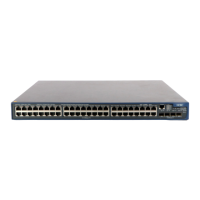Operation Manual – NTP
H3C S3600 Series Ethernet Switches-Release 1510 Chapter 1
NTP Configuration
1-8
Note:
To reduce the risk of being attacked by malicious users against opened socket and
enhance switch security, the S3600 series Ethernet switches provide the following
functions, so that a socket is opened only when it is needed:
z Opening UDP port 123 (used for NTP) when NTP is enabled;
z Close UDP port 123 when NTP is disabled.
The preceding functions are implemented as follows:
z When you enable NTP by using the ntp-service unicast-server, ntp-service
unicast-peer, ntp-service broadcast-client, ntp-service broadcast-server,
ntp-service multicast-client, or ntp-service multicast-server command, UDP
port 123 is opened at the same time.
z When you disable NTP from operating in any modes by using the undo forms of the
preceding six commands, UDP port 123 is closed at the same time.
I. NTP client mode
z The remote server specified by the remote-ip or server-name argument serves as
the NTP server. The local S3600 Ethernet switch serves as the client. The clock of
the client is synchronized to the NTP server, while the clock of the NTP server is
not synchronized to the client.
z The IP address specified by the remote-ip argument cannot be a broadcast
address, a multicast address, or the IP address used by the local reference clock.
II. NTP peer mode
z The remote server specified by the remote-ip or peer-name argument serves as
the peer of the local Ethernet switch, and the local Ethernet switch operates in the
active peer mode. The clock of the local switch can be synchronized to the remote
server or used to synchronize the clock of the remote server.
z The IP address specified by the remote-ip argument cannot be a broadcast
address, a multicast address, or the IP address used by the local reference clock.
III. NTP broadcast server mode
When an S3600 Ethernet switch operates in NTP broadcast server mode, it broadcasts
clock synchronization packets periodically. The devices in NTP broadcast client mode
will respond to these packets and start the clock synchronization process.

